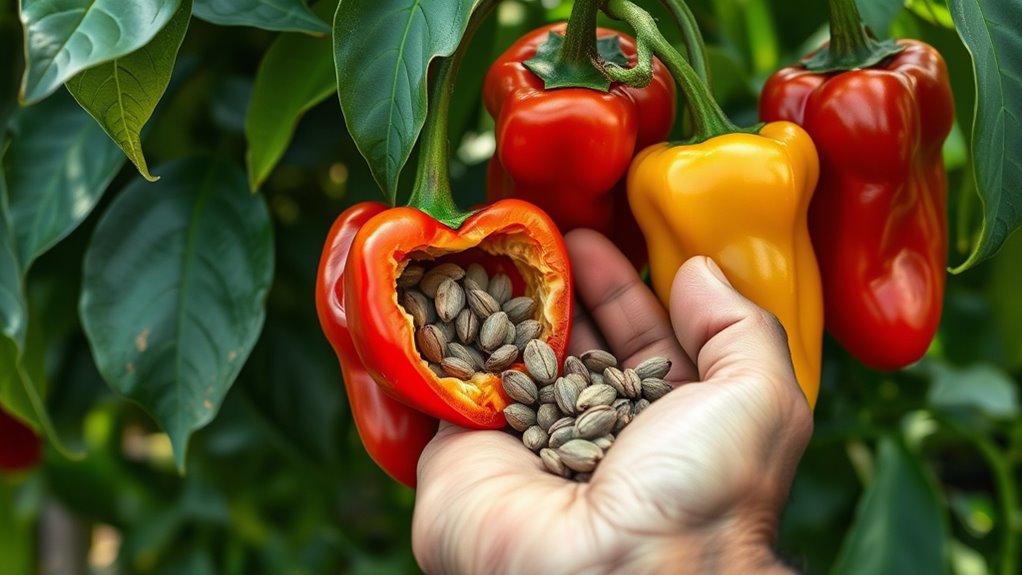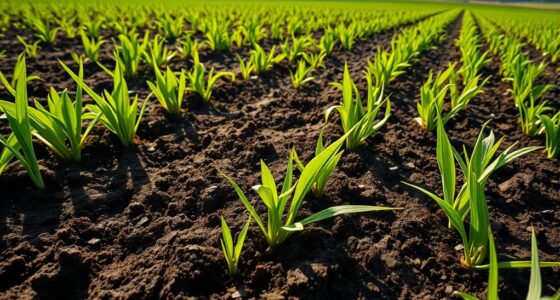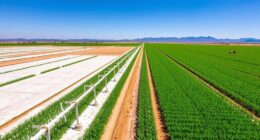To save seeds from open-pollinated peppers, start by selecting mature, healthy peppers with desirable traits from plants that are isolated to prevent cross-pollination. Harvest peppers when fully ripe, then extract and rinse the seeds. Dry them thoroughly in a cool, well-ventilated spot and store in airtight containers labeled clearly. Proper organization and testing for viability guarantee healthy future plants. If you want to master seed saving techniques, keep exploring this guide for detailed steps.
Key Takeaways
- Select fully ripe, healthy peppers from true-to-type open-pollinated varieties for seed harvesting.
- Extract seeds by removing pulp, rinsing, and drying them thoroughly in a well-ventilated, cool area.
- Minimize cross-pollination by isolating plants through distance or barriers before flowering.
- Store seeds in airtight containers with labels indicating variety and harvest date for longevity.
- Test seed viability by germinating a few seeds on a damp paper towel before planting.
Choosing the Right Peppers for Seed Saving
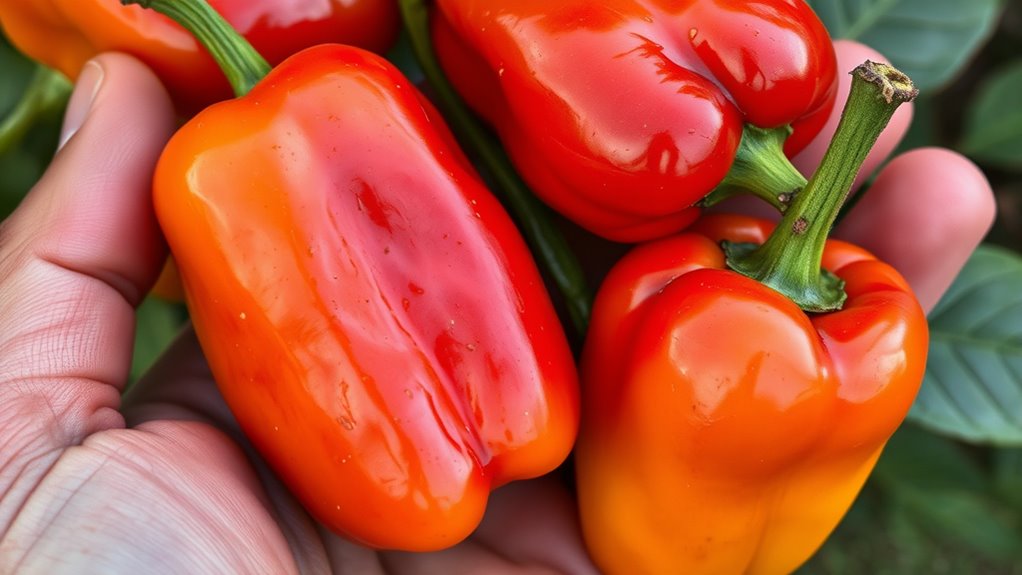
Choosing the right peppers for seed saving is essential to guarantee your future crops are true to the parent plant. You want to select healthy, mature peppers from a reliable pepper variety that shows desirable traits, such as flavor, size, and disease resistance. Ensuring seed purity is vital; avoid peppers that have been cross-pollinated with other varieties, as this can lead to unpredictable offspring. Focus on peppers that have ripened fully on the plant, as mature seeds produce better germination rates. Keep in mind that selecting the best quality peppers helps maintain the genetic integrity of your seed stock. By choosing carefully, you’ll improve your chances of growing consistent, high-quality peppers in the seasons to come. Additionally, understanding the pollination process can help you better manage cross-pollination issues to ensure seed purity.
Understanding Pollination and Cross-Pollination Risks
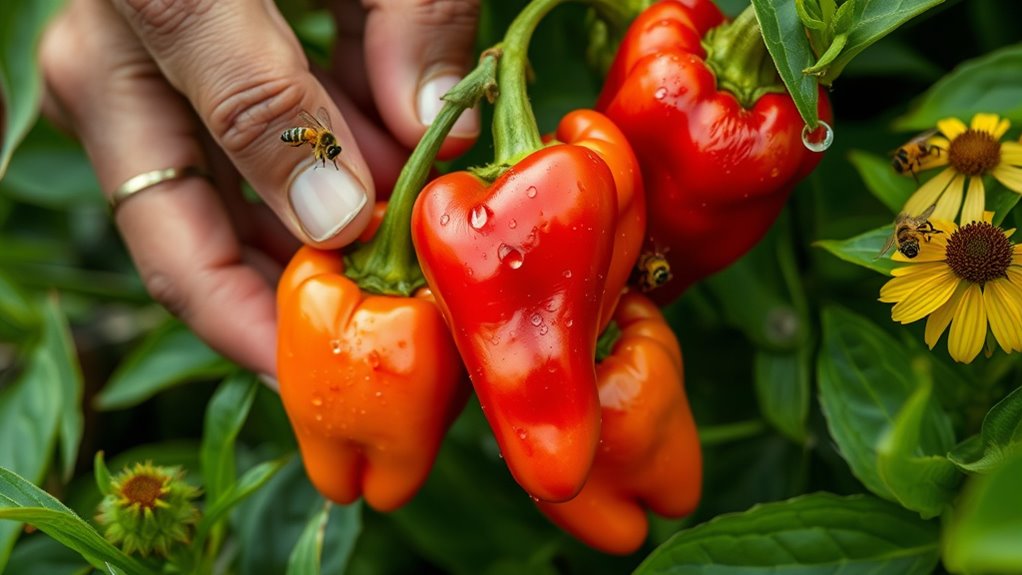
Understanding how pollination occurs in peppers helps you grasp the risks of cross-pollination, which can alter the traits of your seed stock. Peppers use various pollination methods, primarily self-pollination and cross-pollination. Cross-pollination risks increase when multiple pepper varieties grow nearby, risking unwanted genetic mixing. To minimize these risks, consider:
- Isolating plants by distance or barriers to prevent pollen transfer.
- Timing flowering so only your chosen peppers bloom simultaneously.
- Controlling pollinators like bees, which carry pollen between plants. Being aware of the pollination methods helps you better manage your seed saving practices. Understanding natural pollination processes can further aid in developing effective isolation strategies. Additionally, understanding the pollination distances can help you determine appropriate spacing for your plants. Recognizing the pollination mechanisms involved can also assist in selecting suitable isolation techniques. Knowing these pollination methods and managing cross-pollination risks ensures your saved seeds maintain the desired traits, leading to more reliable and true-to-type peppers in the future. Proper understanding helps you protect your seed stock and achieve consistent results.
Timing Your Harvest for Optimal Seed Maturity
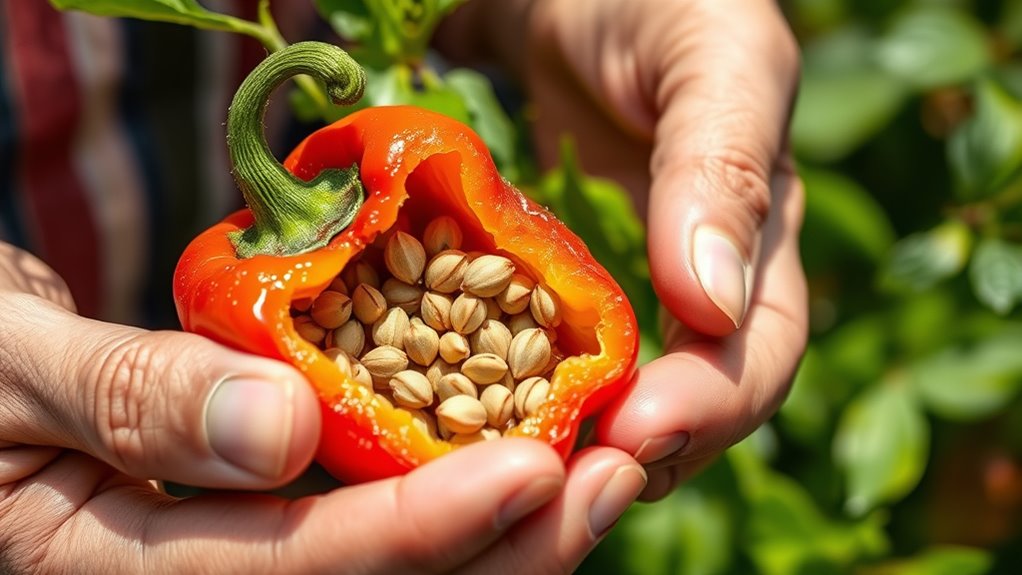
Timing your harvest correctly is essential to guarantee your pepper seeds reach full maturity and have the best chance of germinating successfully. Watch for ripening indicators like color change, firmness, and seed development. Typically, peppers are ready to harvest when they turn their mature color and feel firm. For seed saving, wait until the fruit is fully ripe, often when the pepper has developed its final color and begins to soften slightly. Use this table to guide your harvest timing:
| Ripening Indicator | When to Harvest | Notes |
|---|---|---|
| Color change | Fully colored | Indicates ripeness |
| Firmness | Slightly firm | Seeds are mature |
| Seed development | Seeds swell and mature | Confirm seed readiness |
| Pepper softness | Slight softening | Signifies ripeness |
| Overall size | Reached mature size | Ideal for seed collection |
Proper timing guarantees high seed viability and successful germination. Additionally, understanding seed maturity helps ensure the seeds you save will germinate reliably in future planting seasons. Recognizing the importance of seed storage conditions can further support the vitality of your saved seeds, as proper seed storage conditions and oil treatments can enhance seed longevity. For optimal results, storing your seeds in a cool, dry place can significantly extend their seed viability period.
Extracting and Cleaning Pepper Seeds
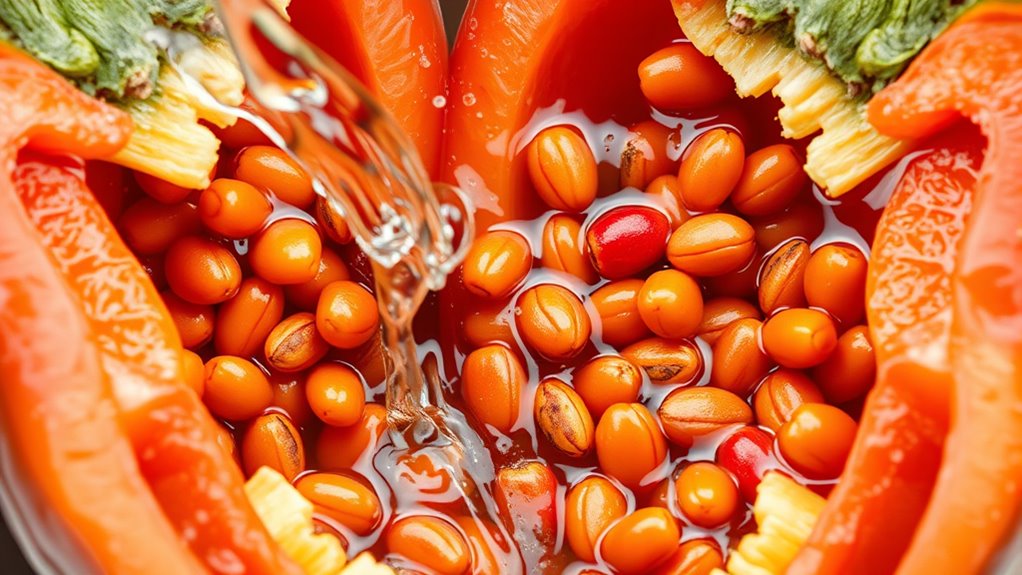
Once you’ve harvested your ripe peppers, the next step is to extract and clean the seeds to guarantee they remain viable for future planting. Start with seed extraction by slicing open the peppers and scooping out the seeds. To clean them effectively, follow these steps:
- Rinse the seeds in water to remove pulp and debris.
- Gently rub the seeds to detach any remaining fruit material.
- Spread the seeds on a paper towel and let them dry briefly before storing.
- Incorporate proper drying techniques during cleaning to ensure only healthy seeds are saved, minimizing the risk of mold or disease. Ensuring the seeds are kept in a cool, dry environment during drying helps preserve their viability.
Proper seed cleaning ensures healthy germination and prevents mold. Be careful not to damage the seeds during extraction, and always remove any damaged or moldy seeds. Doing this carefully sets a strong foundation for successful seed saving and future pepper crops. Additionally, proper storage methods can significantly increase seed longevity and viability over time. Maintaining optimal humidity levels during storage further helps prevent deterioration of the seeds.
Drying and Storing Seeds Properly
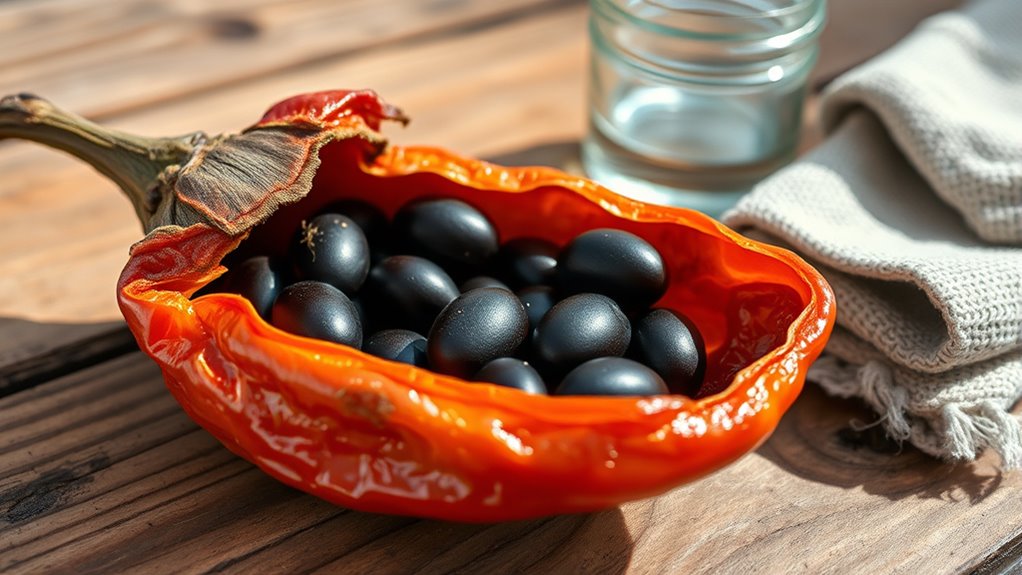
Once you’ve cleaned your seeds, proper drying is essential to prevent mold and guarantee viability. You should dry them in a cool, well-ventilated area until they feel completely dry to the touch. Using high-quality seeds helps ensure successful germination and healthy plant growth. Storing seeds in airtight containers away from light and humidity helps keep them viable for future planting. Additionally, understanding merchant services can assist in purchasing the necessary supplies for seed storage and processing. Choosing the right air purifier features can also help maintain optimal conditions in your storage area. Incorporating data privacy considerations in your seed storage practices can further protect your valuable resources from unauthorized access. Implementing fraud prevention tools when purchasing supplies online can safeguard your transactions and personal information.
Proper Drying Techniques
To guarantee your pepper seeds remain viable, proper drying is vital. Effective drying preserves the seed coat, ensuring seed coat preservation and preventing mold. It also helps maintain moisture control, which is essential for seed longevity. Here’s how to do it right:
- Hang the peppers in a warm, well-ventilated area, avoiding direct sunlight.
- Check regularly for dryness; seeds should feel firm and not sticky.
- Once dry, remove seeds carefully and store in airtight containers, keeping moisture out.
- Using proper drying techniques can significantly extend the viability of your saved seeds. Additionally, employing best storage practices ensures your seeds stay viable for future planting. Proper drying also prevents the development of mold and fungus, which can compromise seed quality.
Avoid rushing this process, as incomplete drying can lead to mold or seed deterioration. Proper drying techniques ensure your seeds stay viable, ready for future planting. Remember, controlling moisture and preserving the seed coat are key to successful seed saving.
Optimal Storage Conditions
Achieving ideal storage conditions is crucial to maintaining seed viability over time. Proper seed storage involves controlling moisture levels to prevent mold, rotting, or seed deterioration. Keep seeds in a cool, dark, and dry environment, such as a sealed glass jar or an airtight container. Use silica gel packets or desiccants to help with moisture control, ensuring seeds stay dry. Avoid storing seeds in humid areas like kitchens or basements, where fluctuating temperatures and humidity can compromise quality. Label your seed containers clearly with variety and collection date. Regularly check stored seeds for signs of moisture or mold, and ensure they remain dry. With proper seed storage, you’ll maximize germination rates and preserve your pepper seeds for future planting seasons.
Labeling and Organizing Your Seed Collection
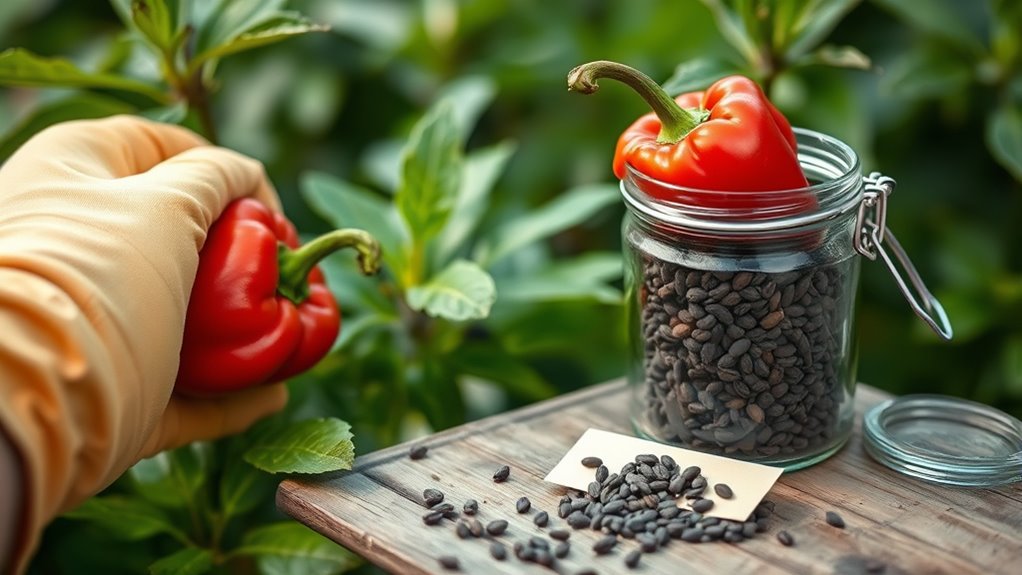
Proper labeling and organization make it easier to find and use your seed collection later. Use durable labels that won’t fade or fall off over time, and categorize seeds by plant type for quick identification. Keep track of seed harvest dates to guarantee you know when your seeds are at their freshest and most viable.
Using Durable Labels
Ever wondered how to keep your seed collection organized and guarantee you can easily identify each variety later? Using durable labels is key. First, choose waterproof, tear-resistant labels designed for outdoor use. These durable labels withstand moisture and handling, ensuring your seed packet labels stay clear and legible over time. Second, write clearly with a permanent marker, including variety name, harvest date, and planting notes. This prevents confusion during planting season. Third, attach labels securely to each seed packet or container, avoiding loose or flimsy options. Proper labeling saves you time and effort later, helping you track your seeds accurately. Investing in durable labels guarantees your seed collection remains organized, accessible, and long-lasting.
Categorizing by Plant Type
Organizing your seed collection by plant type makes it easier to find what you need when planting. Start by sorting seeds based on pepper plant classifications, such as hot peppers, sweet peppers, or specialty varieties. Grouping similar types helps you quickly locate specific seeds and keeps your collection orderly. Use clear labels to identify each category, noting details like variety and year of harvest. This organization streamlines your seed saving techniques, allowing you to track which seeds come from which plant type. Keeping your collection categorized prevents mix-ups and makes future planting more efficient. By maintaining a structured system, you’ll save time and reduce confusion, ensuring your open-pollinated pepper seeds stay organized and ready for planting season.
Tracking Seed Harvest Dates
Tracking seed harvest dates is essential for maintaining a healthy and reliable seed collection. It helps you identify the best seed for future planting and improves seed germination success. To stay organized, consider these steps:
- Record the exact harvest date on each seed packet or container, so you know how fresh your seeds are.
- Note the maturity stage of the pepper when you harvest, since seeds from fully ripe fruit tend to germinate better.
- Keep a seed journal to track which harvest dates yield the best seed selection and germination rates over time.
This system ensures you’re always aware of your seed stock’s age and quality, making planting more predictable and successful. Properly track your seed harvest dates optimizes your seed collection’s longevity and viability.
Testing Seed Viability Before Planting
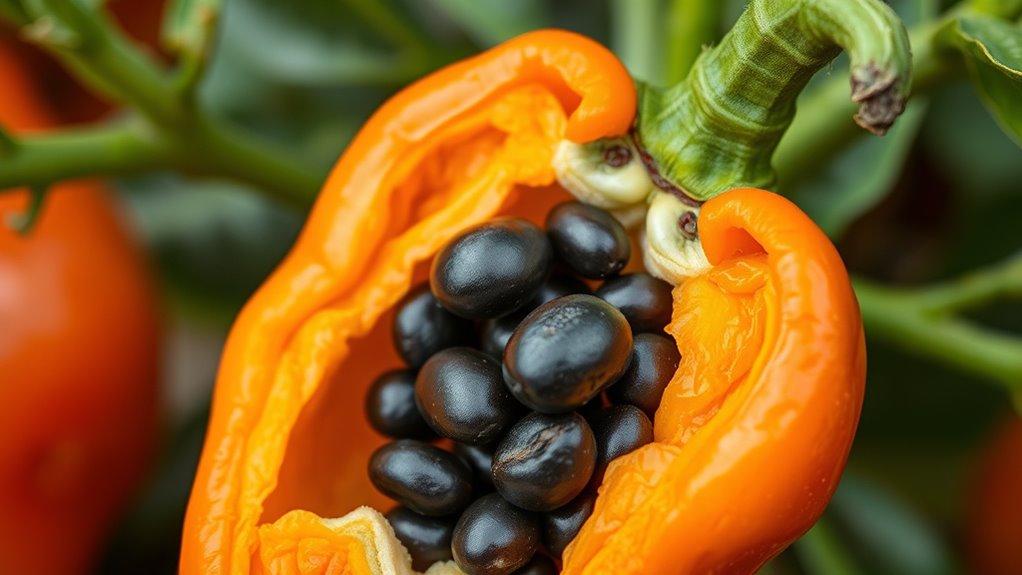
Before planting your saved pepper seeds, verify their viability to guarantee a successful crop. Seed viability testing helps determine if your seeds have good seed germination potential. To do this, place a few seeds on a damp paper towel, then fold and keep them in a warm, dark place. Check after a few days for signs of germination, like sprouting roots or shoots. If most seeds show germination, your seed viability is high, and you can confidently plant more. If few seeds sprout, consider testing more seeds or acquiring fresh seed stock. This simple test saves time, effort, and resources by ensuring you’re planting viable seeds that are likely to grow into healthy plants. Proper viability testing gives you confidence in your seed’s potential.
Tips for Maintaining Genetic Diversity and Healthy Plants
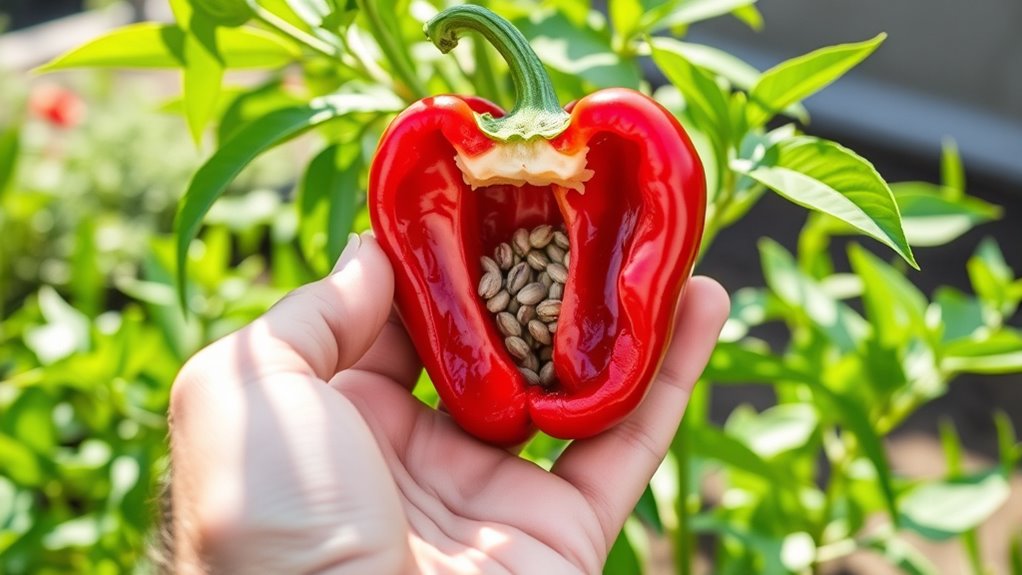
Maintaining genetic diversity in your pepper plants is essential for ensuring resilience against pests and diseases, as well as promoting vigorous growth. To achieve this, focus on preserving genetic variation by growing multiple varieties and avoiding over-reliance on a single cultivar. Here are some tips:
- Grow diverse varieties to prevent narrowing of gene pools.
- Isolate different peppers to reduce unwanted cross-pollination.
- Save seeds from healthy, vigorous plants to promote strong plant health and genetic robustness.
Frequently Asked Questions
How Long Can Saved Pepper Seeds Remain Viable?
You might wonder how long saved pepper seeds stay viable. Typically, seed viability lasts about 2 to 4 years with proper seed storage techniques. To maximize longevity, keep seeds in a cool, dry, and dark place in airtight containers. Proper seed storage techniques help preserve germination rates, ensuring you get healthy plants even years after harvesting. Regularly check stored seeds and discard any that show signs of mold or damage.
Can I Save Seeds From Hybrid Peppers?
You might find it surprising, but saving seeds from hybrid peppers isn’t ideal if you’re after true-to-type plants. Hybrid seeds often don’t reliably produce the same fruits because of cross-pollination techniques used by breeders. For seed preservation, focus on open-pollinated varieties. If you do save hybrid seeds, expect unpredictable results. To guarantee quality, isolate your plants during pollination and plan to reseed with proven open-pollinated varieties for consistent harvests.
Are There Any Pests or Diseases to Watch for During Seed Saving?
When saving seeds, you should watch for pests like aphids and diseases such as blight. Using pest resistant varieties can reduce issues, and practicing good disease management strategies helps keep your seeds healthy. Regularly inspect your plants and seeds throughout the season. Properly drying and storing seeds also minimizes the risk of pests and diseases. Staying vigilant guarantees your seeds remain viable and free from contamination.
How Does Seed Saving Differ for Heirloom Versus Open-Pollinated Peppers?
Think of seed saving as capturing a snapshot of a pepper’s soul. With heirloom peppers, you preserve genetic diversity by ensuring they’re open-pollinated, allowing natural pollination methods to shape their unique traits. For open-pollinated peppers, you follow similar steps, but heirlooms often have a richer history. Both require careful isolation to prevent unwanted cross-pollination, ensuring your saved seeds stay true to their origins and maintain their vibrant flavors and resilience.
What Are Common Mistakes to Avoid When Saving Pepper Seeds?
When saving pepper seeds, avoid pollination errors by guaranteeing plants are isolated to prevent cross-pollination. Don’t neglect cleaning your seeds thoroughly; seed contamination can lead to weaker plants or unwanted traits. Also, skip harvesting seeds too early or too late, as this affects viability. Always label your seeds and keep them dry. These steps help preserve your open-pollinated peppers’ true characteristics and ensure healthy future crops.
Conclusion
By following these steps, you’ll become the gardener guiding your peppers’ genetic story, ensuring each seed carries the legacy of healthy, vibrant plants. Think of seed saving as planting a future filled with potential, where patience and care nurture a garden of possibility. With a little attention and knowledge, you’ll turn each harvest into a treasure chest of life, keeping your pepper varieties thriving like a well-tended symphony waiting to be played anew.

